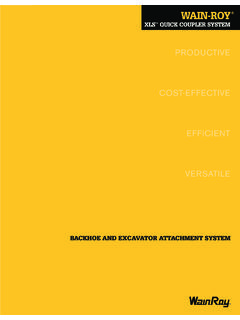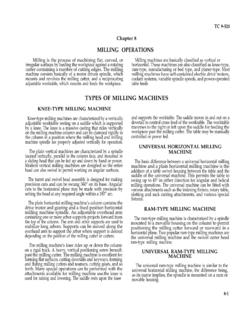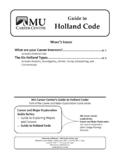Transcription of Safe use of combination metalworking machines …
1 1 of 4 pagesHealth and Safety ExecutiveHealth and Safety ExecutiveHSE information sheetEngineering Information Sheet No 13 (Revision 2)Safe use of combination metalworking machinesIntroduction This guidance is for employers and operators of combination metalworking machines (see Figure 1). These types of machines are also referred to as universal metal workers or steel workers . They are versatile and perform a wide range of operations, including punching, notching, cropping, shearing and bending. The guidance has been produced in order to assist with meeting legal duties specified in the Provision and Use of Work Equipment Regulations 1998 (PUWER 98).1 It gives practical guidance on safe use of the and risks Mechanical hazards, including trapping, crushing and exposure to cutting tools, exist at the different work stations on combination metalworking machines . Trapping or crushing hazards may also arise from unintended or uncontrolled movement of the workpiece and although uncommon, injuries from the ejection of broken tooling have also occurred.
2 Many of the accidents that occur at this type of machine result in very serious injury to the operator s hands, including amputations. A significant number of injuries are associated with tasks that involve small workpieces. It is important that the limitations of these machines are recognised by both employers and operators. The manufacturer s recommendations should be followed in relation to limits for workpiece size and geometry and where special or high-strength steels are to be worked. SafeguardsGeneral The guards on these types of machines should be constructed and fitted so that each workstation can be used independently without another workstation presenting a hazard to the operator or any other person. Guards should be designed so that there is no access to trapping points between closing tools, punches or blades from all sides. In most circumstances it is practicable for workstations to be effectively guarded using either fixed, adjustable or self-closing guards (see BS EN 953).
3 2 It may also be possible to eliminate hazards by restricting gaps at potential trapping points, eg punches to below 4 mm (see BS EN ISO 13857).3 Enclosed tooling can be used where appropriate. Where a view of the workpiece or tool is required for alignment purposes, suitable slots may be incorporated into guards, alternatively, weld mesh or transparent materials may be used. Workpieces should always be properly supported. In particular, small workpieces being punched, notched, etc should be worked on tables which are properly designed, incorporating workpiece guide bars and stops. The correct setting of guide bars and stops should minimise the need for operators to interfere with guards. PunchingCroppingShearingNotchingFigure 1 2 of 4 pagesHealth and Safety ExecutiveWhere a foot operated control is used the pedal/lever should be protected to prevent accidental operation (see PD 5304).4 All guards should be suitable for the purpose for which they are provided and be of good construction, sound material and adequate strength to withstand the stresses of the expected service conditions.
4 In addition, guards must be maintained in an efficient state, in efficient working order and in good repair. Where tooling stations are adapted, or tooling is changed in order to perform other operations, the principles in this guidance should be applied to ensure safety of Punching stations must be provided with fixed or adjustable guards which prevent finger or hand access to the dangerous punching tools. The design of some stripper plate assemblies may provide some degree of protection but any remaining accessible trapping points must be guarded (see Figure 2). The construction of the guards will be determined primarily by the range of workpiece sizes and geometry. Feed openings and other apertures should be in accordance with BS EN ISO 2 Punching station (work table fitted)Trapping points may be eliminated by setting gaps at under 4 mm or enclosed tooling may be used with appropriate restrictions on stroke length. Notching Notching stations must be provided with fixed or adjustable guards which prevent finger or hand access to the dangerous notching tools (see Figure 3).
5 Modified guarding arrangements may be necessary if the workpiece, eg channel section, prevents the use of the normal guards. Figure 3 Notching station (work table fitted) Shearing and cropping Shearing and cropping stations must be provided with fixed or adjustable guards at the feed side of the machine in order to prevent access to the dangerous cropping and shearing tools. Workpiece guides or hold-down devices (see Figure 4), which restrict access to the blades and prevent undue movement of the workpiece during shearing and cropping operation,s should also be provided. Where any gaps remain which could allow finger access to the dangerous tools, eg between a workpiece guide and the body of the machine , additional guarding should be 4 Shearing and cropping station Guard withvision slotsAdjustable guardwith vision slotsGuide bars/stopsFixed guard3 of 4 pagesHealth and Safety ExecutiveAdequate guarding must also be provided at the take-off side of the machine (see Figure 5).
6 Fixed, adjustable or self-closing guards must be provided in order to prevent access to the dangerous shearing and cropping tools. The guard openings must be restricted to allow only for the passage of the workpiece and workpieces should not be taken off by hand. A suitably constructed sloping take-off table or chute should be used which discharges into a pan or box. Larger workpieces may be taken off onto a table or roller track. These or similar handling aids should be designed to minimise the need for a second operator to approach the hazardous parts. Figure 5 Cropping and shearing rear guards Cut-to-length gauging devices will also assist in promoting the safe use of the machine . Such equipment should minimise the need to view the workpiece/tool and therefore any need to disturb the guards. Bending Tooling similar in principle to that used on press brakes may be used for bending operations (at the punching station). The gap between the tooling should be set to as low as possible, typically on these types of machines 4 mm or less.
7 The gap adjustment mechanism should be secured to prevent unauthorised adjustment by the operator. If gaps greater than 4 mm are required at the tools, additional safeguards are necessary and further advice should be obtained from the manufacturer. Bending should only be performed on machines which have been designed for this purpose. Emergency stop controlsOne or more emergency stop controls should be provided where appropriate. Emergency stop controls should be readily accessible. Where emergency stop controls are activated, the machine should only operate again when the emergency stop device has been reset manually and normal operating controls are used to restart the machine (see BS EN ISO 13850).5 Information, instruction and training All relevant health and safety information and, where appropriate, written instructions on the use of combination metalworking machines must be made available to operators. Adequate training should make sure that those who use the machine are competent to use it safely.
8 This includes making sure they have the correct skill, knowledge and risk awareness, and are physically suited to the not let unauthorised, unqualified or untrained people use machinery never allow young people under the minimum school leaving age, eg on work experience, to operate or help at machines . Some workers, eg new starters, young people or those with disabilities, may be particularly at risk and need additional instruction, training or supervision. References1 Safe use of work equipment Provision and Use of Work Equipment Regulations 1998. Approved Code of Practice and guidance L22 (Fourth edition) HSE Books 2014 BS EN 953:1997+A1:2009 Safety of machinery. Guards. General requirements for the design and construction of fixed and movable guards British Standards Institution3 BS EN ISO 13857:2008 Safety of machinery. Safety distances to prevent hazard zones being reached by upper and lower limbs British Standards Institution4 PD 5304:2014 Guidance on safe use of machinery British Standards Institution5 BS EN ISO 13850:2008 Safety of machinery.
9 Emergency stop. Principles for design British Standards InstitutionFurther readingHealth and safety in engineering workshops HSG129 (Second edition) HSE Books information for suppliers, installers and users of new and second-hand machinery can be found on HSE s Work equipment and machinery webpages typeguard withstop. Flap mayalso be of thesegmentedtypeHealth and Safety Executive4 of 4 pagesPublished by the Health and Safety Executive EIS13(rev2) 10/15 Further informationFor information about health and safety, or to report inconsistencies or inaccuracies in this guidance, visit You can view HSE guidance online and order priced publications from the website. HSE priced publications are also available from guidance is issued by the Health and Safety Executive. Following the guidance is not compulsory, unless specifically stated, and you are free to take other action.
10 But if you do follow the guidance you will normally be doing enough to comply with the law. Health and safety inspectors seek to secure compliance with the law and may refer to this guidance. British Standards can be obtained in PDF or hard copy formats from BSI: or by contacting BSI Customer Services for hard copies only Tel: 0845 086 9001 email: document is available Crown copyright If you wish to reuse this information visit for details. First published 05/94.

















